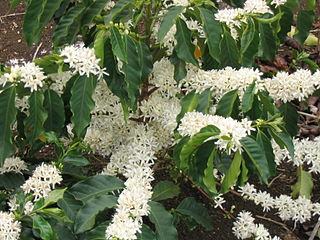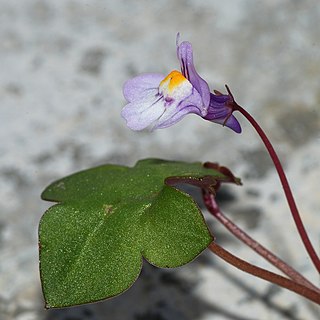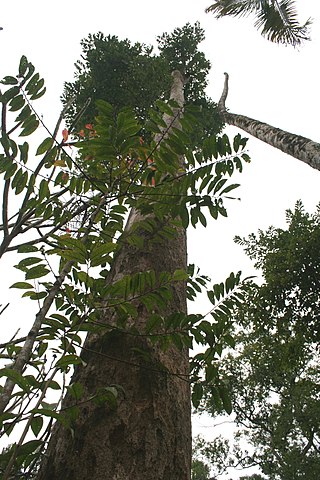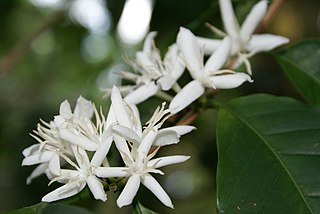
Coffea is a genus of flowering plants in the family Rubiaceae. Coffea species are shrubs or small trees native to tropical and southern Africa and tropical Asia. The seeds of some species, called coffee beans, are used to flavor various beverages and products. The fruits, like the seeds, contain a large amount of caffeine, and have a distinct sweet taste and are often juiced. The plant ranks as one of the world's most valuable and widely traded commodity crops and is an important export product of several countries, including those in Central and South America, the Caribbean and Africa.

Cymbalaria is a genus of about 10 species of herbaceous perennial plants previously placed in the family Scrophulariaceae, but recently shown by genetic research to be in the much enlarged family Plantaginaceae.

Terminalia is a genus of large trees of the flowering plant family Combretaceae, comprising nearly 300 species distributed in tropical regions of the world. The genus name derives from the Latin word terminus, referring to the fact that the leaves appear at the very tips of the shoots.

Myrica is a genus of about 35–50 species of small trees and shrubs in the family Myricaceae, order Fagales. The genus has a wide distribution, including Africa, Asia, Europe, North America and South America, and missing only from Australia. Some botanists split the genus into two genera on the basis of the catkin and fruit structure, restricting Myrica to a few species, and treating the others in Morella.

Entandrophragma is a genus of eleven known species of deciduous trees in the family Meliaceae.

Berlinia is a genus of plants in the family Fabaceae.
Loesenera is a genus of plants in the family Fabaceae.
Plagiosiphon is a genus of plants in the family Fabaceae.
Tetraberlinia is a genus of plants in the family Fabaceae.
Antrocaryon is a genus of flowering plants in the cashew family, Anacardiaceae. The genus is found in Tropical West Africa to Uganda.

Madhuca is a genus of plants in the family Sapotaceae first described as a genus in 1791.
Droogmansia is a genus of flowering plants in the legume family, Fabaceae. It belongs to the subfamily Faboideae.

Coffeeae is a tribe of flowering plants in the family Rubiaceae and contains about 333 species in 11 genera. Its representatives are found in tropical and southern Africa, Madagascar, the western Indian Ocean, tropical and subtropical Asia, and Queensland.
Bikinia is a genus of flowering plants in the family Fabaceae. It belongs to the subfamily Detarioideae.
Aeglopsis is a genus of flowering plants belonging to the family Rutaceae.
Guyonia is a genus of flowering plants belonging to the family Melastomataceae.
Strephonema is a genus of flowering plants belonging to the family Combretaceae.
Lemyrea is a genus of flowering plants belonging to the family Rubiaceae.
Cola verticillata is a species of tree in the genus Cola, of the family Malvaceae, native to the forests of tropical Africa. Common names include owe cola, slippery cola and mucilage cola. It was first described by the Danish botanist Peter Thonning as Sterculia verticillata, and was given its current name of Cola verticillata by the Austrian botanist Otto Stapf and the French botanist Auguste Chevalier.







